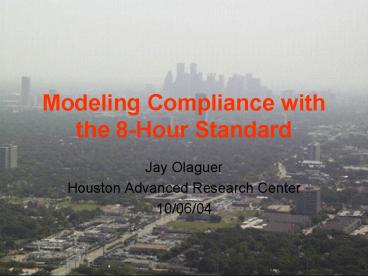Modeling Compliance with the 8-Hour Standard - PowerPoint PPT Presentation
Title:
Modeling Compliance with the 8-Hour Standard
Description:
Fund research to improve ozone science and air modeling in East Texas ... Formation (e.g., PAN, acetone) 8-Hr Conceptual Model. Explain high background ozone in E. TX ... – PowerPoint PPT presentation
Number of Views:17
Avg rating:3.0/5.0
Title: Modeling Compliance with the 8-Hour Standard
1
Modeling Compliance with the 8-Hour Standard
- Jay Olaguer
- Houston Advanced Research Center
- 10/06/04
2
Texas Environmental Research Consortium
- TERC is a consortium of stakeholders
- Local government agencies (City of Houston, HGB
and DFW counties) - Environmentalists (ED, GHASP)
- Business and Industry (GHP, Dallas C of C).
- TERCs mission
- Fund research to improve ozone science and air
modeling in East Texas - 5 million from TX Legislature for 2004-2005
- Collaboration with TCEQ in identifying research
3
Basic Problem
- How to model attainment of 8-hr standard?
- Transport yields background up to 80 ppb
- Current AQ models used for SIPs are barely
sufficient for 1-hr, let alone 8-hr - Selection of appropriate episode(s) not
straightforward (Full ozone season?) - Need much more observational data to evaluate
model performance
4
Meteorology
- 1-hr Standard 8-hr Standard
- Boundary Layer Free Troposphere
- (0-3 km) (3-16 km)
- Horizontal Flow Vertical Motion
5
Transport
- 1-hr Standard 8-hr Standard
- Daytime Night-time
- Urban-to-Regional Regional-to-Continental
6
Chemistry
- 1-hr Standard 8-hr Standard
- Highly Reactive Moderately Reactive
- VOCs (e.g., ethylene) VOCs (e.g.,
n-butane) - Rapid Ozone Long-Lived Products
- Formation (e.g., PAN, acetone)
7
8-Hr Conceptual Model
- Explain high background ozone in E. TX
- Explain local 8-hour exceedances in HGBPA, DFW,
NE TX EAC areas. - Information sources surface monitors, previous
conceptual models, trajectory analyses, forecast
modeling (NCAR) - Statistical and physical model analysis to get a
mental picture of causal mechanism
8
Transport from Out-of-State
- Examine transport impact of out-of-state sources
on E. Texas regions - Apportion source region/type contributions for
various meteorological episodes - Aug 1999 DFW episode
- Sep 1999 Austin/San Antonio episode
- Aug/Sep 2000 HGB episode
- Sensitivity to height of air column in model
9
Best Practice for Modeling 8-Hr Ozone in Context
of TexAQS II
- Real-time trajectory and grid modeling for
forecasting/adaptive observation planning - Testing of modeling innovations
- Observational data assimilation
- Expanded chemical mechanism
- Source attribution methods
- Development of regional model for 8-hour SIP
applications
10
Summer 2005 Tetroon Campaign
- Constant altitude balloons to track air flow
- Tower and/or chase aircraft chemical measurements
(ozone, VOCs, NOy) - Research Focus
- Nocturnal meteorology and transport
- Nocturnal chemistry
- Export of pollution from Houston to E. Texas
11
Summary
- Meteorology
- Conceptual model development
- Testing model innovations during TexAQS II
- Transport
- Regional modeling and source apportionment
- Tetroon campaign to track regional air flow
- Chemistry
- Chemical measurements on tower/aircraft
- Expanded model chemical mechanism

